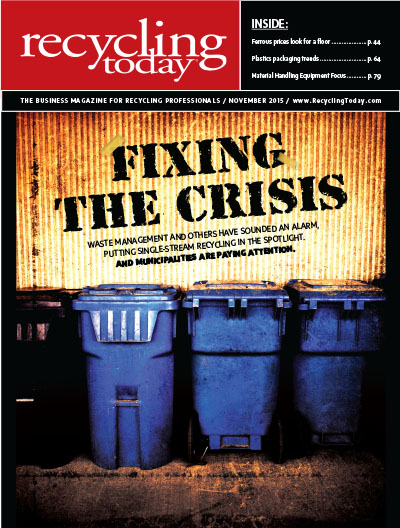Amid some of the lowest nonferrous scrap prices the recycling industry has seen in recent years, the slight bounce across the board in early October, touched off by a Glencore announcement of production cutbacks for zinc, seemed to signal how volatile the sector can be.
Will Adams, head of research for the commodities research service Fastmarkets (www.fastmarkets.com), observes that while a surplus of refined copper was expected this year and next, supply disruptions have tempered those expectations.
“These have been large and unexpected,” Adams says of the disruptions, adding that the production cutbacks “certainly reduced the size of the anticipated surplus,” firming prices.
He says low prices on the London Metal Exchange in recent months likely have sparked some producers to make cuts.
Furthermore, he says the markets seemed to breathe a sigh of relief in early October with expectations that the U.S. Federal Reserve Bank’s Federal Open Market Committee perhaps wasn’t ready to raise interest rates.
On the flip side, however, concerns about the slowdown in China’s economy and its related slowing demand for commodities continue to dog copper markets, Adams says.
“People are fairly pessimistic about growth rates in China,” he says. “We still see it slowing down, and that’s the main reason why prices are under pressure.”
Brian Shine, president of Manitoba Corp., based in Buffalo, New York, observes that the rise in copper pricing of around 8 cents per pound has led to a flurry of scrap buying activity, proving the volatility of the business from day to day.
However, he says recent weeks and months have been very quiet in terms of consumer demand, which to some extent is normal around this time of the year. Still, he says, “It may be kind of a limp to the finish line.”
He adds, “Everyone is scrambling to make sales, so consumers are taking the position of just-in-time inventory, and even ‘just-just-in time.’”
A highly unusual facet of today’s markets, Shine says, is that while generation is down, spreads on scrap have been reasonable. “With demand being really weak, processors don’t have to reach as much,” he explains.
Regarding aluminum scrap prices, Matt Kripke, president of the nonferrous scrap brokerage business Kripke Enterprises, Toledo, Ohio, conjectures that based on his 22 years of industry experience, “we have to be near a bottom on aluminum.”
Kripke says that while retail generation has begun to slow over the last couple of months, industrial generation remains strong.
“A lot of those grades that are steel-driven are just not coming in,” he says. One example is 356 aluminum wheels, which have dropped in volume significantly from a year ago. Kripke says the low price of steel has made it difficult for auto wreckers to purchase cars.
Aluminum extrusions are strong, Kripke says, with good competition for high-grade mill scrap.
“There’s no shortage of people willing to quote and pay aggressive numbers on those items,” he says, adding that billet makers seem to have the strongest appetites for those items now.

Explore the November 2015 Issue
Check out more from this issue and find you next story to read.
Latest from Recycling Today
- Bridgestone introduces retreating plant virtual tour
- USTMA announces Tire Recycling Foundation
- Dow announces agreement with Freepoint and MOU for Asia Pacific market with SCGC
- Mixed signals chracterize ferrous market
- Researchers look into ironing out a secondary aluminum limitation
- Analysis: Chemical recycling’s ‘inflection point’ nearing
- Machinex system in Québec targets organics diversion
- Northern Shenandoah region awarded $3.9M for recycling infrastructure






